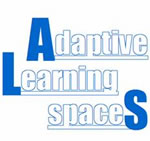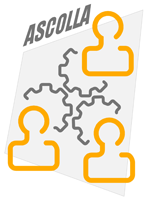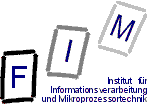Research
An overview of past and current work on:
- Adaptive systems (this page),
- eLearning, and
- Accessibility.
Adaptive systems
Our latest work on adaptive systems has been in the context of the Adaptive Learning Spaces, and the ASCOLLA projects.
We are also working on a generic adaptation engine for web-based systems. This is a derivative of the work done in PALIO (details below), and aspires to provide some preliminary facilities for designing and implementing meta-adaptive / self-regulating systems on the web.
Further to the design and implementation of adaptive systems, I am also very much interested in their evaluation.
To date, I have participated in the development of three adaptive systems, all of which were developed in the context of European collaborative research projects. These systems were (in reverse chronological order): PALIO, AVANTI and ACCESS.
» Meta-adaptation / Self-regulation
Self-regulation is a form of meta-adaptivity and, in simplified terms, it refers to an adaptive system's capacity to improve its adaptive behaviour through learning. For a relatively complete introduction to the field, you may want to refer to this paper:
- Paramythis, A. (2004). Towards Self-Regulating Adaptive Systems. In Weibelzahl, S., & Henze, N. (Eds.), Proceedings of the Annual Workshop of the SIG Adaptivity and User Modeling in Interactive Systems of the German Informatics Society (ABIS04), Berlin, October 4-5 (pp. 57-63).
For an example of ways in which meta-adaptivity, and self-regulation in particular, can affect our current approaches to designing and implementing adaptive systems, you can have a look at the papers below accepted for publication in AH2006. Actually, the first of the two papers, accepted for presentation in the main track of the conference, is a short version of the second, accepted for publication in the joint A3H and A3EH workshop.
- Paramythis, A. (2006). Can adaptive systems participate in their design? Meta-adaptivity and the evolution of adaptive behaviour. Proceedings of the Fourth Adaptive Hypermedia and Adaptive Web-Based Systems 2006 Conference (AH 2006), June 21-23, 2006, Dublin, Ireland. (5 pages, page numbers not availabel yet) (short version)
- Paramythis, A. (2006). Self-regulated adaptivity as a design and authoring support tool. Proceedings of the joint 1st International Workshop on Authoring of Adaptive and Adaptable Hypermedia (A3H) and the 4th International Workshop on Authoring of Adaptive & Adaptable Educational Hypermedia (A3EH), held in conjunction with the Fourth Adaptive Hypermedia and Adaptive Web-Based Systems 2006 Conference (AH 2006), June 21-23, 2006, Dublin, Ireland. (12 pages, page numbers not availabel yet) (long version)
Work in this area is moving along two axes: (a) development of the formal theoretical basis for self-regulation, and (b) implementation and integration of self-regulatory bahaviour in an adaptattion "engine".
» Generic adaptation "engine"
This is the second of the main things I am working on at the moment (the first being self-regulating adaptive systems). Here is a rough sketch of the ideas involved:
The engine is applicable to any web-based system that has an XML "pipeline", or has an XML-based representation of the document (fragments) to be returned to the user, at any stage of the request-response cycle. The engine supports adaptation "performatives", which can be thought of as adaptation "verbs" that encapsulate adaptation techniques at different levels of granularity, or manipulate the system's adaptation models.
The engine defines programmatic interfaces (based on pre-defined, yet flexible information flows) through which different modelling and decision-making components can be plugged in. Standard implementations of these components are made available, including: (a) a simple user modelling component, supporting overlay modelling (with respect to the application's domain model(s)), as well as independent user properties; (b) a simple rule-based decision-making component; and, (c) a rather more advanced logic-based decision-making component. Alternative implementations are, of course, possible. Provided that a small set of prerequisites is met, there is also the possibility to create "adapters" that enable existing components to be plugged into the engine without modifications.
Semantic web technologies are used for the ontological specification of the application's domain model, as well as for "linking" together adaptation models, adaptation logic and adaptation performatives.
Perhaps the most important feature of the engine is a number of features intended to facilitate the implementation of self-regulating adaptive systems (i.e., systems that can modify their adaptive behaviour through "learning" based on self-evaluation). The system's self- evaluation and regulation principles will be specified in a declarative manner. Naturally, these features will depend heavily upon (and would, therefore, constrain) the approaches used in creating the dynamic adaptation models (especially the user model) and in drawing adaptation decisions.
In summary, the goals of the ongoing work are: to create an adaptation engine that can be applied to multiple application domains; to support the declarative specification of a wide range of adaptive system behaviours; to provide preliminary support for creating self-regulating adaptive systems; and, to enable the integration of alternative adaptation components. Finally, an overarching objective in the implementation of the engine is to make it orthogonal to common web application architectures, so that the only requirement for integrating it in existing systems is the one stated above: have an XML representation (with XHTML and even HTML also being possible) of the "served" document, at any stage of the request-response cycle.
If you find the above interesting and would like more information,
or if you would like to participate in the ongoing developments,
please feel free to send me an email to ![]() .
.
» Evaluation of adaptive systems
My interest in the evaluation of adaptive systems is mainly from the perspectives of deriving design feedback, and of validating common adaptive methods and techniques in different application domains. A fact that is well-established by now is that adaptive systems cannot be evaluated as if they were not adaptive. Several of the few related studies in the literature have arrived at inconclusive results. In my view, the problem lies with the fact that traditional evaluation approaches fail to address / cater for the adaptation "cycle" and the potential failure points therein. Thus, when the evaluation of an adaptive systems indicates problems (e.g., user dissatisfaction, non-use of adaptive features, etc.), it is not possible to pin-point the source of these problems: wrong user model, problems with the adaptation theory, wrong adaptation strategy, inappropriate method or technique used, ... ?
While working in ICS-FORTH, we started fleshing out an evaluation "framework" which might help address these issues. The main concept of the approach was to "break down" the adaptation cycle and devise an evaluation process that could address each of the cycle's constituents. This effort was reported in:
- Paramythis, A., Totter, A., & Stephanidis, C. (2001). A modular approach to the evaluation of Adaptive User Interfaces. In S. Weibelzahl, D. Chin & G. Weber (Eds.), Proceedings of the Workshop on Empirical Evaluations of Adaptive Systems, held in the context of the 8th International Conference on User Modeling (UM'2001), 13-17 July, Sonthofen, Germany (pp.9-24). Freiburg: Pedagogical University of Freiburg.
At roughly the same time, two additional frameworks appeared in the literature, which were based on the same principles:
- Brusilovsky, P., Karagiannidis, C., & Sampson, D. (2001). Benefits of Layered Evaluation of Adaptive Applications and Services. In S. Weibelzahl, D. Chin and G. Weber (Eds.) Empirical Evaluation of Adaptive Systems. Proceedings of workshop held at the Eighth International Conference on User Modeling in Sonthofen, Germany, July 13th, 2001, pp. 1-8, Freiburg: Pedagogical University of Freiburg.
- Weibelzahl, S. (2003). Evaluation of Adaptive Systems. Dissertation. University of Trier, Germany.
Given the similarities and complementarity between the "modular" and the "layered" approaches, Stephan Weibelzahl and myself decided to join forces and arrive at a single layered evaluation framework for adaptive systems. Some of the first outcomes of our work have been recorded in:
- Paramythis, A. & Weibelzahl, S. (2005). A Decomposition Model for the Layered Evaluation of Interactive Adaptive Systems. In Ardissono, L., Brna, P., & Mitrovic, A. (Eds.), Proceedings of the 10th International Conference on User Modeling (UM2005), Edinburgh, Scotland, UK, July 24-29 (pp. 438-442) (Lecture Notes in Computer Science LNAI 3538, Springer Verlag). Berlin: Springer.
In the process of working on the merger, we have also expended considerable efforts in bringing together researchers and practitioners interested in the topic. These efforts gave rise to the series of workshops on "User-Centred Design and Evaluation of Adaptive Systems", the fifth installment of which is being organised in conjunction with the 4th International Conference on Adaptive Hypermedia and Adaptive Web-Based Systems (AH2006).
![]() We
have also established EASy-Hub,
a site devoted to the subject of evaluating adaptive systems. Our main
goals in establishing the site were, firstly, to create a central "repository" of
information and knowledge on the subject, and, secondly, to provide
an interactive space to which others can contribute. We hope that the
site will be embraced by the community, and will, over time, become
a valuable resource for evaluators (but also designers) of adaptive
systems.
We
have also established EASy-Hub,
a site devoted to the subject of evaluating adaptive systems. Our main
goals in establishing the site were, firstly, to create a central "repository" of
information and knowledge on the subject, and, secondly, to provide
an interactive space to which others can contribute. We hope that the
site will be embraced by the community, and will, over time, become
a valuable resource for evaluators (but also designers) of adaptive
systems.
» PALIO
The "official" preamble:
PALIO was a European Commission funded research project that addressed the issue of Universal Access to community-wide services, based on content- and interface- level adaptation, beyond desktop access. The main challenge of the PALIO project was the creation of an open system for the unconstrained access and retrieval of information (i.e., not limited by space, time, access technology, etc.). Under this scenario, mobile communication systems play an essential role, because they enable access to services from anywhere and at anytime. One important aspect of the PALIO system has the support for a wide range of communication technologies (mobile or wired) to facilitate access to services.
PALIO proposed a new approach to the provision of tourist services in an integrated, open structure, based on the concurrent adoption of the following concepts: (a) integration of wireless and wired telecommunication technologies to offer services through both fixed terminals in public places and mobile personal terminals (e.g. mobile phones, PDAs, laptops); (b) location awareness to allow the dynamic modification of information presented (according to user position); (c) adaptation of the contents to automatically provide different presentations depending on user requirements, needs and preferences; (d) scalability of the information to different communication technologies and terminals; (e) interoperability between different service providers in both the envisaged wireless network and the World Wide Web.
The IST-1999-20656 PALIO project (1999-2002) was partly funded by the Information Society Technologies Programme of the European Commission – DG Information Society. The partners in the PALIO consortium were: ASSIOMA S.p.A. (Italy) – Prime Contractor; CNR-IROE (Italy); Comune di Firenze (Italy); FORTH-ICS (Greece); GMD (Germany); Telecom Italia Mobile S.p.A. (Italy); University of Sienna (Italy); Comune di Siena (Italy); MA Systems and Control Ltd (UK); FORTHnet (Greece).
I worked on PALIO, while I was a member of ICS-FORTH. To get an idea of what PALIO was about, you could refer to the following publications (electronic copies of "non-downloadable" papers available upon request):
- Paramythis, A., & Stephanidis, C. (2005). A Generic Adaptation Framework for Hypermedia Systems. In Chen, S. Y., & Magoulas, G. D. (Eds.) Adaptable and Adaptive Hypermedia Systems (pp. 80-103). Idea Group, Inc. (A preliminary version of this chapter is available for download)
- Stephanidis, C., Paramythis, A., Zarikas, V., & Savidis, A. (2004). The PALIO Framework for Adaptive Information Services. In A. Seffah & H. Javahery (Eds.), Multiple User Interfaces: Cross-Platform Applications and Context-Aware Interfaces (pp. 69-92). Chichester, UK: John Wiley & Sons, Ltd. (A preliminary version of this chapter is available for download)
- Emiliani, P.L., Paramythis, A., Burzagli, L., & Stephanidis, C. (2003). PALIO as an enabling platform for disabled and elderly people. In C. Stephanidis, (Ed.), Universal Access in HCI: Inclusive Design in the Information Society - Volume 4 of the Proceedings of the 10th International Conference on Human-Computer Interaction (HCI International 2003), Crete, Greece, 22-27 June (pp. 547 - 551). Mahwah, New Jersey: Lawrence Erlbaum Associates.
- Paramythis, A., Alexandraki, C., Segkos, I., Maou, N., & Stephanidis, C. (2003). Personalisable, context-aware services: the PALIO approach. In C. Stephanidis, (Ed.), Universal Access in HCI: Inclusive Design in the Information Society - Volume 4 of the Proceedings of the 10th International Conference on Human-Computer Interaction (HCI International 2003), Crete, Greece, 22-27 June (pp. 582 - 586). Mahwah, New Jersey: Lawrence Erlbaum Associates.
- Paramythis, A., Alexandraki, C., Segkos, I., Maou, N., & Stephanidis, C. (2003). The PALIO framework for hypermedia adaptations. In C. Stephanidis, (Ed.), Universal Access in HCI: Inclusive Design in the Information Society - Volume 4 of the Proceedings of the 10th International Conference on Human-Computer Interaction (HCI International 2003), Crete, Greece, 22-27 June (pp. 587 - 591). Mahwah, New Jersey: Lawrence Erlbaum Associates.
You may wish to have a look at a few screenshots of PALIO in action.
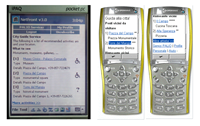 |
The first
set shows PALIO |
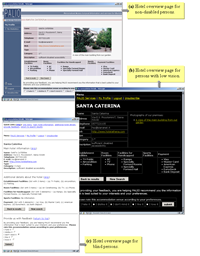 |
» AVANTI
The most comprehensive publications of the work done by ICS-FORTH in AVANTI are (electronic copies of "non-downloadable" papers available upon request):
- Stephanidis, C., Paramythis, A., Sfyrakis, M. & Savidis, A. (2001). A Case Study in Unified User Interface Development: The AVANTI Web Browser. In C. Stephanidis (Ed.) User Interfaces for All - Concepts, Methods, and Tools (pp. 525-568). Mahwah, NJ: Lawrence Erlbaum Associates.
- Stephanidis, C., Paramythis, A., Sfyrakis, M., Stergiou, A., Maou, N., Leventis, A., Paparoulis, G., & Karagiannidis, C. (1998). Adaptable and Adaptive User Interfaces for Disabled Users in the AVANTI Project. In S. Trigila, A. Mullery, M. Campolargo, H. Vanderstraeten & M. Mampaey (Eds.), Intelligence in Services and Networks: Technology for Ubiquitous Telecommunications Services - Proceedings of the 5th International Conference on Intelligence in Services and Networks (IS&N '98), Antwerp, Belgium, 25-28 May (pp. 153-166). Berlin: Springer, Lecture Notes in Computer Science, 1430.
» ACCESS
This was the project that "started it all" for me, as far as adaptive systems are concerned! A very important research project that laid the theoretical foundations of Unified User Interface Development, as well as User Interfaces for All, and Universal Access in HCI in a broader context. For more information on these topics you can refer to the excellent materials available from the web site of the HCI Lab, in ICS-FORTH. Other resources that may be of interest in the area:
- The proceedings of the biannual workshops of the ERCIM working group "User Interfaces for All".
- The first, second, and third International Conferences on "Universal Access in Human - Computer Interaction (UAHCI)", as well as the forthcoming (July 2007) fourth installment of the series.
- The first and second ACM Conferences on Universal Usability (also, don't miss universalusability.org, the Universal Usability portal).
- The Springer journal "Universal Access in the Information Society".
- The book "User Interfaces for All - Concepts, Methods, and Tools", edited by Prof. Constantine Stephanidis. Mahwah, NJ: Lawrence Erlbaum Associates (ISBN 0-8058-2967-9).
- The book "Leonardo's Laptop", by Prof. Ben Schneiderman. MIT Press (ISBN 0-2621-9476-7).
